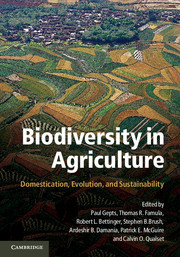Book contents
- Frontmatter
- Contents
- Tables
- Figures
- Foreword
- Contributors
- Acknowledgments
- Introduction: The Domestication of Plants and Animals: Ten Unanswered Questions
- 1 The Local Origins of Domestication
- Section I Early Steps in Agricultural Domestication
- Section II Domestication of Animals and Impacts on Humans
- Section III Issues in Plant Domestication
- 13 The Dynamics of Rice Domestication: A Balance between Gene Flow and Genetic Isolation
- 14 Domestication of Lima Beans: A New Look at an Old Problem
- 15 Genetic Characterization of Cassava (Manihot esculenta Crantz) and Yam (Dioscorea trifida L.) Landraces in Swidden Agriculture Systems in Brazil
- 16 Pigeonpea: From an Orphan to a Leader in Food Legumes
- Section IV Traditional Management of Biodiversity
- Section V Uses of Biodiversity and New and Future Domestications
- Index
- References
15 - Genetic Characterization of Cassava (Manihot esculenta Crantz) and Yam (Dioscorea trifida L.) Landraces in Swidden Agriculture Systems in Brazil
Published online by Cambridge University Press: 05 June 2012
- Frontmatter
- Contents
- Tables
- Figures
- Foreword
- Contributors
- Acknowledgments
- Introduction: The Domestication of Plants and Animals: Ten Unanswered Questions
- 1 The Local Origins of Domestication
- Section I Early Steps in Agricultural Domestication
- Section II Domestication of Animals and Impacts on Humans
- Section III Issues in Plant Domestication
- 13 The Dynamics of Rice Domestication: A Balance between Gene Flow and Genetic Isolation
- 14 Domestication of Lima Beans: A New Look at an Old Problem
- 15 Genetic Characterization of Cassava (Manihot esculenta Crantz) and Yam (Dioscorea trifida L.) Landraces in Swidden Agriculture Systems in Brazil
- 16 Pigeonpea: From an Orphan to a Leader in Food Legumes
- Section IV Traditional Management of Biodiversity
- Section V Uses of Biodiversity and New and Future Domestications
- Index
- References
Summary
Swidden or slash and burn agriculture begins in prehistory and has been modified by humans with the addition of various components through its evolution (Martins 2001). In pre-Columbian times, only some indigenous people of the Americas became involved in agriculture. In North America, the Atlantic tribes reached this stage. All the Central American tribes cultivated the soil, whereas in South America the traditional swidden field is an inheritance from the Indians, who used fire to burn the woods and subsequently prepare fields for cultivation for three consecutive years (Oliveira et al. 1994). As productivity declines owing to depletion of soil nutrients, the area is abandoned, leading the way for ecological succession. Once abandoned, fields are allowed to return to a more natural state as native plant and tree species reclaim the field. As a result, over a period of time soil nutrient levels can return to pre-disturbance levels, although the resulting ecosystems often retain a preponderance of plant species used by humans. While recovering, abandoned fields (also known as “swiddens”) are typically used by humans as a source of fruits, nuts, fibers, medicinal plants, and game. Once ecosystem recovery is sufficiently advanced, the field may be used again for cultivation (Cornell and Miller 2007). This agriculture model, which uses low energy input and intense family labor, is practiced in different regions of the world, such as the cultivation of rice fields in Asia and the itinerant cropping systems in Africa (Martins 2001, Altieri 2002).
In Brazilian swidden agriculture, the generation and amplification of crop species diversity by farmers has caught the attention of many researchers, as it is related to a complex system of shifting cultivation, manipulation of wild species by transplanting, harvesting of wild species, attraction of game by increasing the density of fruit trees, and a particular spatial arrangement of the plants in the fields. This allows inter- and intraspecific hybridization to occur, which is a key mechanism for the amplification of genetic variability (Martins 1994, 2001). Therefore, the traditional communities are responsible for the maintenance and increase in species biodiversity cultivated and managed by these farmers (Hanazaki et al. 1996). Traditional swidden fields are destined towards subsistence food production, where associated cropping is a constant practice.
- Type
- Chapter
- Information
- Biodiversity in AgricultureDomestication, Evolution, and Sustainability, pp. 344 - 360Publisher: Cambridge University PressPrint publication year: 2012
References
- 5
- Cited by

